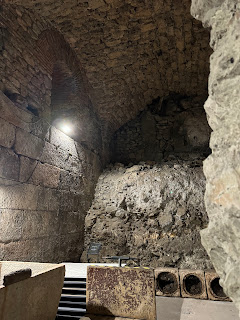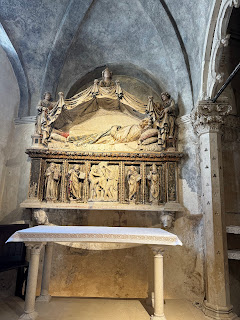Our next stop was the port of Split in Croatia: in particular the palace of Diocletian. The illustration below gives you an idea of its grandeur and scale. (The pointer and the elegant hand are those of our guide.) Note its position, the Adriatic lapping at its walls. Since then, land has been reclaimed, the sea pushed back, allowing some light traffic and the ability to buy ice cream on the promenade. I can seriously recommend their lemon ice cream.
The picture below shows the present-day exterior now largely devoted to restaurants, cafes and shops. Pleasant and nondescript, it’s hard to imagine what lies immediately behind, nor the sea once lapping at its walls.
Because the sea was so close, the original palace had a substantial substrata, nicely cool in the heat of summer, useful for storage, except when heavy rain or tidal surges flooded the cellars. Then, one imagines a subterranean Venice, gondolas by torchlight.
Diocletian, I guess, never imagined they’d one day be used for a key scene in Game of Thrones.
Diocletian, I think, would have approved. He was one of the more interesting Roman Emperors. Over twenty years he almost tamed the Roman bureaucracy, a herculean task akin to ‘draining the swamp.’ Bureaucracy has a function, but for him it had become parasitic, a drain on Imperial power. He divided the empire in the interests of efficiency, and he persecuted Christians, regarding them as the ‘enemy within.’
Obsessed with restoring the power and virility of the Roman empire, he championed the old pagan virtues and saw Christianity as an insidious threat. The Diocletian persecutions were severe and a mirror image of the later Christian persecution of pagans—both claiming the moral high ground.
At last, worn out, Diocletian proved unique amongst emperors by choosing early retirement. He did so in style, his palace both a fortress and a monument to his power. The palace itself covered seven acres, its sea facing walls 7 ft thick and 22 ft high, and 60ft high on its Northern side. It had 16 towers and four gates covering the four points of the compass. Inside, it was organised along the lines of a Roman camp with four arcaded avenues 36 ft wide meeting in the middle. Guards, slaves and servants were housed in the Northern quadrants. The diagram at the top shows you what it would have looked like 1700 years ago. What's left retains much of its grandeur and size
And, below, a small, modern palace within Diocletian's more impressive pile.
The imperial apartments were in the southern quadrants facing the sea. Along their width ran a 524 ft long and 24 ft wide arcaded grand gallery with views of the sea and the Dalmatian coast.
In the Imperial quarter he also built a temple to Jupiter, and a grand mausoleum for his own use after died.
In later years, Diocletian’s palace became a focal point of Christian hatred. His statue was beheaded, along with a series of ancient Egyptian sphinxes that hadn’t laid so much as a finger on a Christian.
A headless sphinx. The Taliban would have been proud.
Christian cathedral still in use. The tall bell tower was attached some time in the C12th. Commonly referred to as the Cathedral of St Domnius, it's a nice illustration of how the wheel turns. St Domnius was martyred (beheaded) by Diocletian in 304 BC. In a nice touch of Christian triumphalism, Diocletian’s temple of Jupiter and personal mausoleum were in turn sanctified as a cathedral and baptistry, The new masters were in town
Diocletian’s sarcophagus was smashed. I’m not too sure what happened to his body, but the mausoleum and its fine Roman barrelled roof remain intact.
This is not a statue of Diocletian showing what he thinks of iconoclastic Christians, but a modern statue of John the Baptist, occupying the space where a statue of Jupiter once stood.
The cathedral of St Domnius is a joy to walk around though, to my mind, there is a kind of moral in the way the richly ornamented altar obscures the actual crucifixion of Christ.
The statue on the altar above commemorates the visit of Pope John Paul's visit to Split and Croatia after its struggle for independence from the failing Yugoslavia.
.
































2 comments:
Can you imagine the palace in its day? Even all these centuries later it still holds its grandeur.
I spent some time, in various parts of the palace, imagining it in its prime. It was mind-stretching and a profound experience, but it lacked the otherworldly dimension of Pompeii
Post a Comment